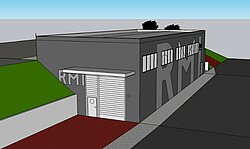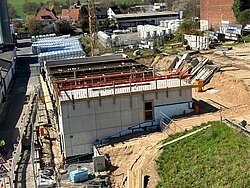New construction of hygrothermal testing hall
In Ober-Ramstadt, a new hall with a floor area of approx. 300 m² is being built for building physics tests.
The following testing facilities are planned:
Hygrothermal double chamber
Climate chambers for simulation of weathering cycles
- Outdoor climate -20 °C to +80 °C with humidity control
(heating via IR radiators or air) and sprinkling
- Indoor climate -20 °C to 80 °C with air humidity control
(heating via air)
- Test cycles according to EAD-<avayaelement class="contentWrapper"><avayaelement callelement="+4940083000404" class="dcelink" id="dceLink-3" originaltext="040083-00-0404">040083-00-0404</avayaelement></avayaelement> and EAD-<avayaelement class="contentWrapper"><avayaelement callelement="+4940089000404" class="dcelink" id="dceLink-4" originaltext="040089-00-0404">040089-00-0404</avayaelement></avayaelement>
- Further individual test cycles for outdoor and indoor climates are freely configurable
Acoustic test bench
Modular combinable double chamber for the determination of acoustic properties of building materials/parts
- Building acoustics, sound insulation based on DIN EN ISO 10140
- Room acoustics, reverberation chamber for measurements of sound absorption coefficient following DIN EN ISO 354
- Acoustic camera for visualization and leakage location
- Expandable to individual test scenarios and noise behavior of fittings and wall installations according to DIN 3822
Device for simulation of driving rain
This method, developed at the RMI, is used to determine the tightness against water penetration of detail connections in the facade area (e.g. window sills and roller shutter boxes)
- Wind speeds from 5 to 120 km/h
- Precipitation rate 5 l/(min m²)
- Variable adjustment of wind direction
All three test facilities are coordinated to a uniform test wall dimension of 4 m x 3 m.
The advantage of this uniform size is that a test structure can be stressed or tested in any combination of the three test facilities.
Thus, external and internal effects on the building envelope can be investigated simultaneously.
Commissioning of the hygrothermal test hall is scheduled for the 4th quarter of 2023.
In addition to standardized building physics suitability tests for products/systems (EADs), this will also provide the opportunity to develop future-proof test scenarios adapted to innovative components (e.g. from the prefab sector), sustainable heating and air-conditioning systems, and changing weather conditions due to climate change.





